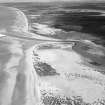Pricing Change
New pricing for orders of material from this site will come into place shortly. Charges for supply of digital images, digitisation on demand, prints and licensing will be altered.
Upcoming Maintenance
Please be advised that this website will undergo scheduled maintenance on the following dates:
Thursday, 9 January: 11:00 AM - 3:00 PM
Thursday, 23 January: 11:00 AM - 3:00 PM
Thursday, 30 January: 11:00 AM - 3:00 PM
During these times, some functionality such as image purchasing may be temporarily unavailable. We apologise for any inconvenience this may cause.
Sands Of Forvie
Lithic Working Site (Prehistoric)
Site Name Sands Of Forvie
Classification Lithic Working Site (Prehistoric)
Canmore ID 87194
Site Number NK02NW 29
NGR NK 010 251
Datum OSGB36 - NGR
Permalink http://canmore.org.uk/site/87194
- Council Aberdeenshire
- Parish Slains
- Former Region Grampian
- Former District Gordon
- Former County Aberdeenshire
NK02NW 29 010 251.
An area of 120m by 60m of an exposed land surface in the dunes near the mouth of the River Ythan was studied. Scatters of flint knapping debris were recorded and collected (including an anvil stone), while a date was implied by the discovery of a barbed-and-tanged arrowhead.
Sponsor: Marischal Museum Young Archaeologists
E Curtis and N Curtis 1994.
NK 01 25 A survey of flint-bearing raised beach surfaces adjacent to those examined by the Marischal Museum Young Archaeologists (Curtis and Curtis 1994) was undertaken. This fieldwork, coupled with the analysis of the 5787 lithics collected by the Marischal Museum, suggests the existence of a number of fairly discrete foci of Mesolithic artefacts and a broader distribution of undiagnostic bipolar and crude flint debris, suggestive of very expedient knapping strategies. A collection of c 4000 artefacts was made from an 8 x 20m transect over the sea cliff through one focused scatter located in a low scoop in this surface. The Mesolithic artefacts are much more numerous on the raised beach itself than beneath it. The artefacts include numerous blades, cores and a range of geometric microliths, especially rod-like forms.
Sponsors: Historic Scotland, Abercromby Fund, Society of Antiquaries of Scotland (NE section).
G Warren 1999.
Field Visit (October 2022)
Visited during fieldwork by SCAPE. Small area of exposed raised beach full of struck flint (Mesolithic). The remainder of the blowout covered in a thick layer of sand. There are further records of past flint scatter finds within the sand blowout, approximately 100m north of this site.
Information from S Boyd and J Hambly - Scottish Coastal Archaeology and the Problem of Erosion (SCAPE)








